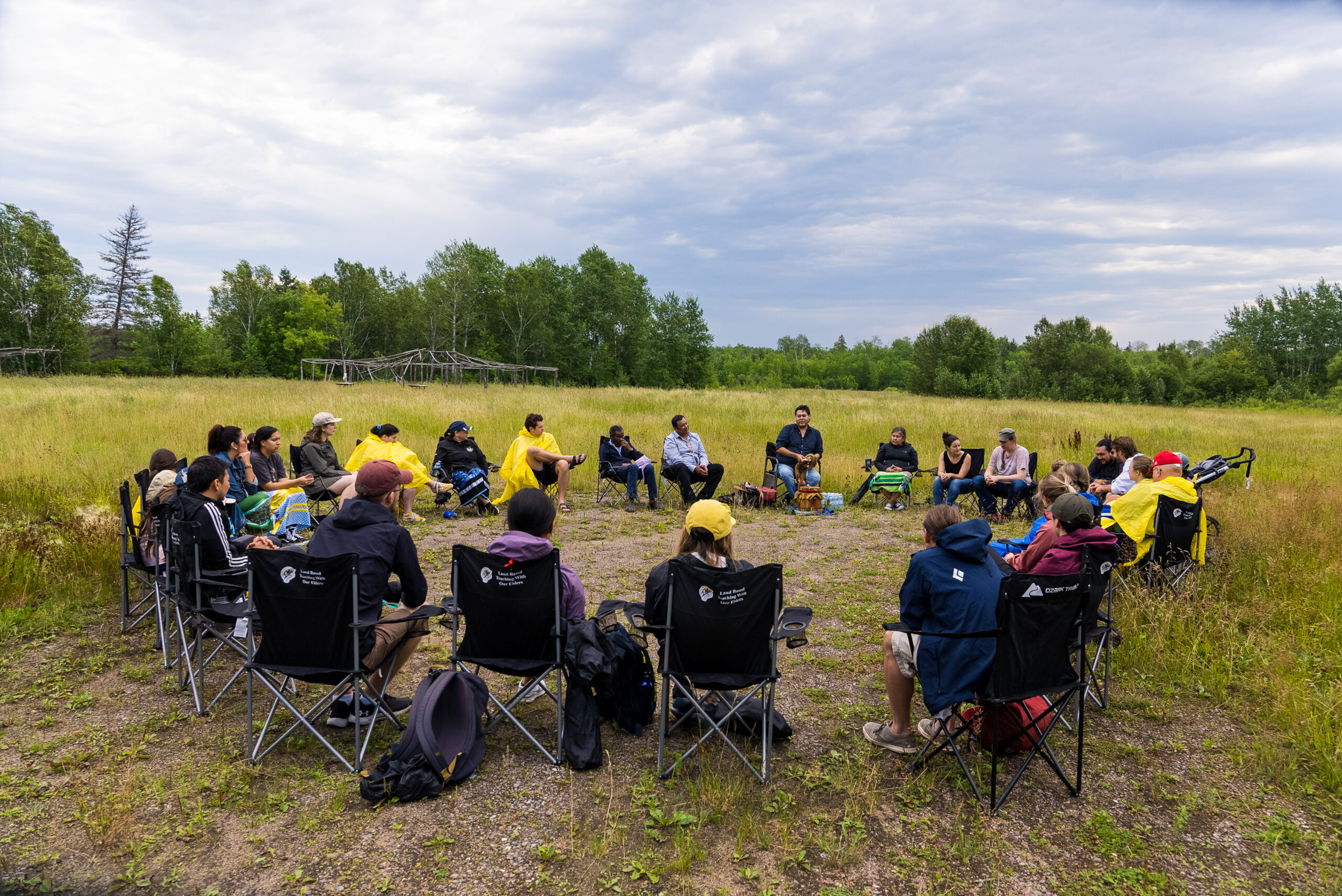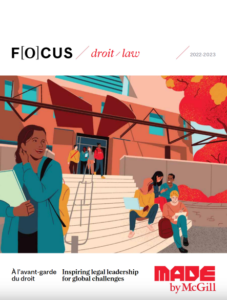
In 2020, responding to the Truth and Reconciliation Commission’s call to engage with Indigenous legal systems, McGill Law introduced a new mandatory course for first-year law students entitled “Indigenous Legal Traditions.”
The Anishinaabe Law Field Study course picks up where this introductory course ends. “This course fully engages Indigenous law on its own terms,” says Mills, who holds the Canada Research Chair in Indigenous Constitutionalism and Philosophy and is Anishinaabeg. “To do that we had to get out of the law school and onto the land, interacting with Indigenous community members.”
Working with knowledge-holders

With this goal in mind, Mills worked with two traditional Anishinaabe knowledge-holders as co-teachers: Elder Harry Bone and Grandmother Sherry Copenace. “They’ve been my teachers for many years, and we bring very different gifts into a circle while sharing the same commitment,” says Mills, who stresses that he has been on a fifteen-year journey, guided by his grandmother, who passed away a year ago, and other elders, to understand Anishinaabe law more fully. “My long-running relationships with them have provided the foundation of this course,” he underscores.
While the differences between Anishinaabe law and the European-based civil and common law traditions are profound, “they perform the same social functions in a very different way,” says Mills. To help students understand it as law rather than just culture, the first week of the course explored Anishinaabe constitutionalism informing its legal understanding. “The Anishinaabe interpretation of the world is that everything is connected, that the earth is inherently good, and the relationships between things are instructive for us, because it’s all part of Creator’s vision of balance and harmony.”
“The fundamental question of social life isn’t ‘the social contract tradition’ where we ask ‘What is a just society, and what institutions and processes are necessary to create and to sustain it?’ Instead, it is ‘How do we fit in to the order which already exists?’”
Anishinaabe law is often expressed in narratives – teachings embedded in stories, songs and ceremonies – that must then be interpreted within the context of an event or conflict. “Instead of a set law, there is only legal reasoning, because in every case, you have to reason towards your answer,” Mills explains. As Mill’s co-teacher Grandmother Sherry Copenace points out, “The law is not meant to force people to do things. Rather we want people, based on whatever teaching we provide them with, to want to comply for their own wellness and for the wellness of society. It’s up to the individual to interpret how to live their responsibility in regard to that law.”

A sense of community
The teachers explored Anishinaabe law in a manner that aligned with Anishinaabe ways of learning. “Typically, we started the day with teachings from Elders or other knowledge keepers on the concept we were discussing, and then we would go around in a circle to share what that meant for us,” says Catherine Dunne, who was entering her second year of studies. At the end of each week, the students would submit written reflections on their learning. “At the start, we wanted the students to find ways on their own to understand the ideas,” Copenace says. But the first set of weekly reflections showed that students were struggling with the fundamental concepts, so the following week the teachers offered concrete examples. “That’s how they were used to learning – but we told them, this is a gift, because it’s not how we usually teach or learn,” Copenace explains.
Students engaged with Anishinaabe law not only in their Monday to Thursday learning circles, but also on Friday field trips, which included a visit to the ancient Whiteshell petroforms at Bannock Point, where an Elder explained their connection to Anishinaabe origin stories. “We were able to go out onto the land for ceremonies, such as participating in a sweat lodge ceremony, and I felt that the wide range of experiences really helped me to have a fuller picture of Anishinaabe law,” says fourth-year student Ellen Spannagel. “The course challenged me in all the right ways. It’s been the best experience of my legal education because not only did I learn a lot about Anishinaabe law on its own terms, but I built valuable relationships with people in my cohort, with the knowledge holders, and with Professor Mills and his family. That sense of community really helped the course come alive.” Indeed, a sense of community is an important feature of Anishinaabe law and, to foster this, Mills organized weekly dinners for all participants.
“The course challenged me in all the right ways.”

All participants expressed hope that the course would become a regular feature of the curriculum. “I thought it was very courageous on McGill’s behalf, and a big step for any university, to come to Manitoba and partner with the TRCM to present this course,” Copenace concluded. “What Professor Mills and McGill have done is say that Indigenous law has always been here – and it’s important.”
The Anishinaabe Law Field Course was based at The Forks in Winnipeg, and the students stayed in a university residence. Funding from one of McGill’s Tomlinson Chairs provided a modest contribution towards expenses for every participant; additional needs-based funding was made available to cover flight and accommodation.
Focus Law/Droit 2022-2023 est maintenant disponible!
Cet article est tiré de la nouvelle édition de Focus Law/Droit, le magazine de la communauté diplômée de la Faculté de droit.
Our latest issue features spotlights on law alumni with outstanding career paths; the return of in-person activities at Chancellor-Day Hall (including visits from our alumni sitting on the Supreme Court of Canada); an infographic celebrating 20 years of world-class legal education through our integrated BCL/JD program; and the latest news from our students and professors. Read it now, and send us your news for our next issue!

